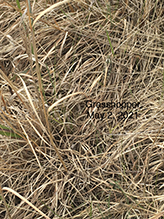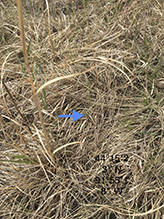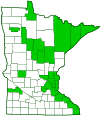coral-winged grasshopper
(Pardalophora apiculata)
Conservation • Description • Habitat • Ecology • Distribution • Taxonomy
Conservation Status |
|
|||||||
| IUCN Red List | not listed |
|||||||
| NatureServe | N5 - Secure |
|||||||
| Minnesota | not listed |
|||||||
Description |
||
Coral-winged grasshopper is a common, large, early season, bandwing grasshopper. It occurs across southern Canada and in the United States from Maine to Tennessee west to Montana and New Mexico. It is common in the eastern half of Minnesota. Adults are found from April through June in prairies, old fields, savannas, and forest openings with grasses, always in areas with very sandy soil. Adults are large, robust, and grayish-brown. Females are 1⅝″ to 2¼″ (42 to 58 mm) in length. Males are smaller, 1¼″ to 1⅝″ (32 to 42 mm) in length. When viewed from the side the top front of the head is angled and the face is broadly rounded. The face is vertical or nearly vertical. There is a distinct, concave, depressed area (fastigium) at the top of the face between the compound eyes, and a small depression (foveola) immediately above each eye. The broad vertical ridge on the face (frontal costa) is narrowed between the antennae. The compound eyes are not bulging and do not extend above the top of the head. The antennae are short, no more than half the length of the body. The plate over the thorax (pronotum) is saddle-shaped and has a distinct longitudinal ridge in the middle. There is a single transverse groove (suculus) across the pronotum that cuts through the ridge. The lateral lobes of the pronotum are rounded and the rear margin is extended. The angle of the triangular extension is less than 90°. It does not extend over the abdomen or beyond the base of the wings. The front part of the pronotum (prozona) is much shorter than the rear part (metazona). On the underside of the thorax there is no spur between the front legs. There is a pair of flat, round, hearing organs (tympani) on the sides of the first abdominal segment. On the female the ovipositor is short and stout. The forewings (tegmina) are long, narrow, and slightly thickened. They have large dark spots and no dark cross bands. The spots are mostly confined to the sides and rear. When folded over the body the top is dark in the basal area, pale on the sides and for most of their length. The pale sides darken gradually toward the center. They do not form distinct stripes. The hindwings are membranous and are folded fan-like when at rest. They are coral red in the discal area, have a broad dark cross band, and are clear at the tip. On the hind legs the third segment (femur) is greatly enlarged and long, as long as the tegmina. The inner face is yellow to orange and is crossed by two broad dark bands. The fourth segment (tibia) is yellow, orange, or coral red. There are two spurs at the end of the tibia. The inner spur is less than twice as long as outer. On all of the legs the end section corresponding to the foot (tarsus) has three segments. The last segment has a pair of claws at the tip. The pad-like structure between the claws (arollium) is extremely small or absent. |
||
Size |
||
Female: 1⅝″ to 2¼″ (42 to 58 mm) Male: 1¼″ to 1⅝″ (32 to 42 mm) |
||
Similar Species |
||
Habitat |
||
Prairies, old fields, savannas, and forest openings; sandy soil |
||
Ecology |
||
Season |
||
April through June |
||
Behavior |
||
Adults are active during the day. |
||
Life Cycle |
||
Eggs overwinter in the soil and hatch the following July. The half-grown nymphs overwinter again and mature in the spring of the following year. Mature adults are present from April through June and are gone by July. |
||
Nymph Food |
||
|
||
Adult Food |
||
Unknown but probably grasses and sedges. |
||
Distribution |
||||
|
Sources Haarstad, J. 1990. The Acrididae of Minnesota. Final report submitted to the Minnesota Department of Natural Resources. 28 pp. |
|||
| 2/8/2022 | ||||
Occurrence |
||||
Common in Minnesota |
||||
Taxonomy |
|||
Order |
Orthoptera (grasshoppers, crickets, and katydids) | ||
Suborder |
Caelifera (grasshoppers, locusts, and allies) | ||
| Infraorder | Acrididea (grasshoppers) | ||
Superfamily |
Acridoidea (short-horned grasshoppers and locusts) | ||
Family |
Acrididae (short-horned grasshoppers) | ||
Subfamily |
Oedipodinae (bandwing grasshoppers) | ||
Tribe |
Hippiscini | ||
Genus |
Pardalophora | ||
Synonyms |
|||
Acridium tuberculatum Hippiscus apiculata Hippiscus tuberculatus Locusta apiculata Locusta corallina Pardalophora obliterata Pardalophora tuberculata |
|||
Common Names |
|||
coral-winged grasshopper coral-winged locust |
|||
Glossary
Fastigium
On some insects, especially Orthoptera: the upper part of the forehead, between and often extending in front of the compound eyes.
Femur
On insects and arachnids, the third, largest, most robust segment of the leg, coming immediately before the tibia. On humans, the thigh bone.
Pronotum
The exoskeletal plate on the upper side of the first segment of the thorax of an insect.
Tegmen
The modified, leathery front wing of some insects that protects the hindwing. It may also serve as a camouflage, a defensive display, or a sound board. Plural: tegmina.
Tympanum
An external hearing structure. In reptiles and amphibians, the circular, disk-like membrane that covers the ear opening. In insects, the membrane covering the air sac and sensory neurons. Plural: tympani.
Visitor Photos |
|||||
Share your photo of this insect. |
|||||
| This button not working for you? Simply email us at info@MinnesotaSeasons.com. Attach one or more photos and, if you like, a caption. |
|||||
Nancy Falkum |
|||||
 |
 |
||||
MinnesotaSeasons.com Photos |
|||||
|
|||||

Slideshows |
||

Visitor Videos |
|||
Share your video of this insect. |
|||
| This button not working for you? Simply email us at info@MinnesotaSeasons.com. Attach a video, a YouTube link, or a cloud storage link. |
|||
Other Videos |
|||
| Coral-winged Grasshoppers facing off Eric Eaton |
|||
About
Aug 23, 2015 Two male Coral-winged Grasshoppers, Pardalophora apiculata, try to intimidate each other by stridulating: making noise by rubbing the inside of the hind femur against the front wings. Cheyenne Mountain State Park, Colorado, USA, April 30, 2015. |
|||

Created: 2/8/2022
Last Updated:


